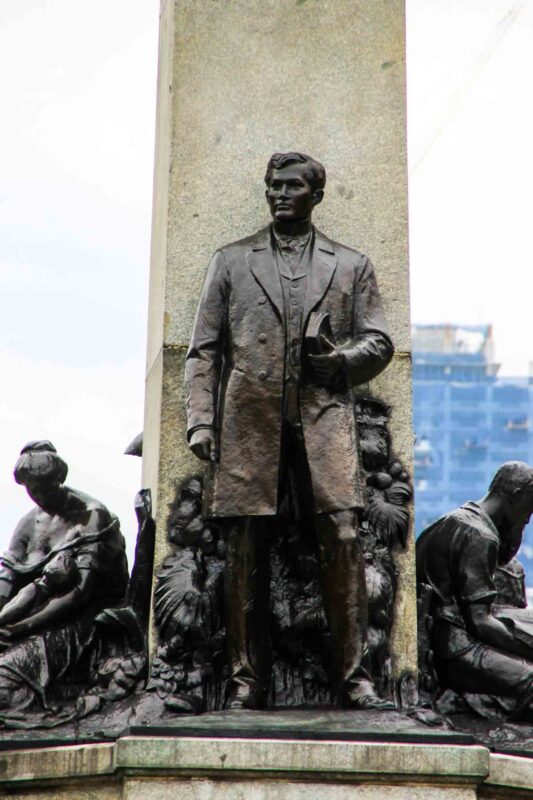
Throughout the archipelago, one is bound to find a statue of Rizal in almost, if not, all of its towns and cities.
NEW YORK—This June 19th (not to be confused with the Juneteenth of the United States) is the 162ndbirth anniversary of José Protasio Rizal—born in Calamba, Laguna, the second of two males in a family of eleven children. There will be the usual commemorations cum celebrations, particularly at the Rizal Park, where the de facto national hero was executed by firing squad in the early morning of December 30, 1896. Originally called Bagumbayan, then Luneta, Rizal Park has as its focal point the Rizal Monument, where his remains are interred,.
Rizal has become a mythical figure in the Philippine imaginary. Infants are christened bearing his name, perhaps with the unspoken hope that the child will grow up to be a hero but sans the execution that rendered the 35-year-old a martyr for a nation about to arise from the ashes of a ravaged land—ravaged both by colonialism and the two wars waged on its soil. Throughout the archipelago, one is bound to find a statue of Rizal in almost, if not, all of its towns and cities. Countless avenues and streets bear his name. In Makati, there used to be a beautiful cinema, the Rizal Theater, with a café, the Rizal Café. One side of the theater was emblazoned with his signature. Spacious, spotless, the Rizal could show 70 mm films; I still vividly recall being entranced, and engulfed, by David Lean’s towering epic Lawrence of Arabia, in a largely empty house. Unfortunately the Rizal was demolished, a sacrificial lamb on the altar of capitalist greed, to make way for a hotel, five stars luxury-wise but none for its bland architecture.
You may also like: Outstanding young Fil-Ams receive Rizal Awards in Washington
Those wishing for a more unconventional way of remembering and otherwise celebrating Rizal’s central role in the formation of a young nation might consider viewing Bayaning 3rd World, the 1999 mockumentary by Mike de Leon. One can view it on YouTube, though there are no subtitles.
Unlike Malou Diaz-Abaya’s straightforward 1998 three-hour biopic, de Leon casts an imaginative and quirky eye on who the man was, behind all the heroic, even saintly, images in the popular imagination. The film centers on two filmmakers, played by Ricky Davao and Cris Villanueva, who plan to make a film on Rizal but haven’t as yet decided on how to approach their subject in a way markedly different from the usual reverential stance.
What de Leon does is have the two filmmakers imagine interviews with Rizal’s mother, Doña Teodora, his sisters, and his dulce extranjera Josephine Bracken, all dressed in period dress while the duo are informally clad in modern-day clothes. They investigate as well the controversial issue of Rizal’s alleged retraction (or not) of his anti-clerical views, which necessitates interviews with the priests who visited Rizal in his Fort Santiago prison cell.
Shot in black and white, with a bit of history regarding the first films made on Rizal, Bayaning 3rd Worlddoesn’t take itself, or its subject, too seriously but does provoke its viewers into reflecting on the phenomenon of hero worship as idolatry, the difficulty of really getting a measure of the man behind the myth, and perhaps arriving at a deeper appreciation and understanding of not only of Rizal but of his time.
At the other end of the spectrum are the religious sects that live on the slopes of Mt. Banahaw, clustered around the town of Kinabuhayan (Resurrection). Intensely nationalistic, such groups as Tres Personas, Solo Dios (Three Persons, One God) revere the 1896 revolutionary figures as akin to saints. Above them all stands José Rizal, venerated by the residents of what is often called the Magic Mountain. To them he is an avatar of a New Order, even a reincarnation of Christ, through whom and in whom they can channel and reassert their long-held claims to an indigenous national identity that in their minds is inseparable from a transcendent spirituality.
Thus do they subtly subvert the hold of both the Catholic Church and the government in Manila, run by the landed and political elite, and long divorced from any meaningful contact with indigenous sentiment. The fact that the American colonial administration promoted Rizal as the national hero principally due to his pacifist views doesn’t seem to bother them. After all, from their point of view, one can still engage in guerrilla warfare but of the spirit, and not kill anyone, whether a foreigner or a Filipino.
The other element that sets these sects apart from the dominant religions is that they are female headed—an example of the pre-colonial matriarchy surviving into the modern era through the person of the babaylan(shaman), more often female than not. Apart from all his sterling qualities, Rizal I am positive was well aware of gender equality cum fluidity, given that his mother was from all accounts a force of nature. In fact, the very notion of Rizal is fluid, something that Bayaning 3rd World makes clear.
To each his or her own Rizal. If he didn’t exist it would have been necessary to invent him.
Copyright L.H. Francia 2023

